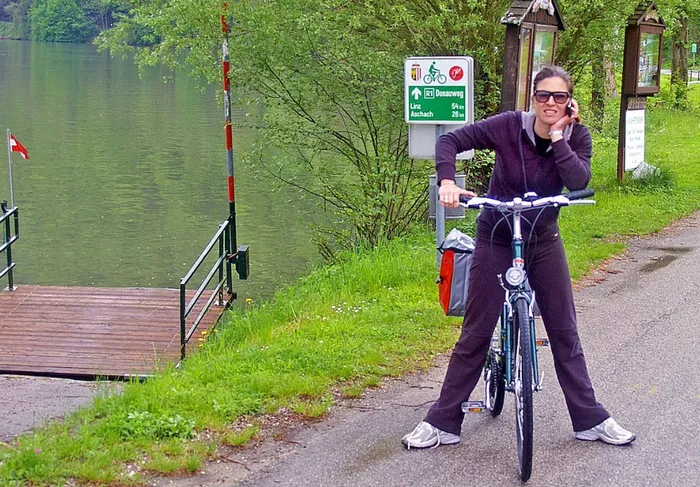Cycling across the Nibelungen Bridge into Linz, Austria’s third-largest city, marked a memorable entry for a determined pair of adventurers—a father and his daughter, Katherine—who embarked on a 350-kilometer cycling tour from Passau, Germany to Vienna. Their six-day journey brought them first to Linz, a city that immediately charmed with its unexpected blend of history, modernity, and revitalized spirit.
Despite a rain-soaked arrival, the city’s vibrant energy quickly shone through. As the clouds parted, rays of sunlight illuminated the historic Hauptplatz—Linz’s vast 13th-century town square—creating a picturesque welcome. Surrounded by grand, uniform buildings and punctuated with architectural landmarks like the Alter Dom (Old Cathedral), the Altes Rathaus (Old Town Hall), and the intricate white-marble Dreifaltigkeitssäule (Holy Trinity Column), the square captured the city’s unique character. Modern touches, like trams gliding across wet cobblestones and vibrant spring blooms, added charm to the scene.
Linz exuded a compelling livability, combining cleanliness and order with a lively, contemporary spirit. Renaissance architecture stood shoulder to shoulder with sleek, modern structures—including the travelers’ four-star hotel. Though arriving soaked and in cycling gear was less than glamorous, the warmth of the city made up for it.
The city’s motto, “Linz changes,” accurately reflects its transformation. Once a gray, industrial hub, Linz has reinvented itself as a center of innovation and culture. Recognized as the 2009 European Capital of Culture, the city is now home to forward-thinking institutions like the Ars Electronica Center. Located across the river, the center functions as both a museum and a creative laboratory, exploring the intersection of robotics, neuroscience, biotechnology, and digital art. At night, its LED-lit glass walls bathe the Danube in a mesmerizing display of color.
Next to this futuristic beacon, more traditional entertainment resides—a circus and funfair operate side by side, offering a contrasting but complementary slice of city life. On the south bank, the Lentos Museum of Art provides another artistic anchor. With its striking black-glass façade and illuminated “LENTOS” inscription, the museum houses an eclectic collection that includes works by Klimt, Schiele, and Warhol.
Navigating Linz by bicycle revealed hidden gems around every corner. Twisting medieval lanes led to the Stadtpfarrkirche, a beautiful baroque church where Emperor Friedrich III is entombed—or at least his bowels are. Like many monarchs of the time, he chose to have his remains distributed across several burial sites, an odd tradition likened here to an animal marking its territory.
Another unexpected delight was the K.u.K. Hofbäckerei, an esteemed bakery dating back to 1371. The rich wood-carved shopfront invited a break for coffee and a slice of the famous Linzer Torte. Inside, faded posters, newspapers, and military memorabilia gave the café a nostalgic aura. The current owner, Fritz Rath, shared the bakery’s royal history, including its esteemed patron Archduke Peter Ferdinand.
Linz’s notable historical figures include astronomer Johannes Kepler and composer Anton Bruckner. Less celebrated is Adolf Hitler, who once envisioned Linz as his cultural capital of Europe. Today, there’s little acknowledgment of that past in the city’s marketing or public memory. A self-guided walking tour of former Gestapo buildings proved underwhelming, as many have since been repurposed or demolished.
Contrary to stereotypes of cultural capitals being limited to stuffy museums and opera houses, Linz demonstrates that culture can be wide-ranging and inclusive. Its institutions span from the renowned Brucknerhaus concert hall and the Landesgalerie art museum, to quirky destinations like the puppet museum, the Akustikon (dedicated to acoustic experiences), the House of Children’s Stories, and even a museum of dental history. The city’s cultural calendar is just as diverse, featuring events such as rock festivals, Easter plays, summer cabarets, and offbeat performances like Der Kranke Hase (“The Sick Hare”).
After a hearty dinner of schweinebraten with sauerkraut, the night was interrupted by fireworks over the Danube—a vibrant close to a day of discovery. The following morning began with brief visits to the Landhaus (provincial parliament building) and Mozarthaus, associated with the Linz Symphony. Before continuing their ride, the cyclists enjoyed a chocolate tasting on Herrenstrasse, once the most prestigious street in Linz and now beautifully restored.
As they pedaled out of the city, the route passed through a lush greenbelt filled with forests, parks, lakes, sports fields, and nature trails—an idyllic escape just minutes from the urban center. At the edge of Linz, vast industrial areas came into view, showcasing the city’s economic roots in chemicals, oil, and steel. Today, these industries thrive alongside Linz’s growing cultural and service sectors, reflecting a city successfully bridging tradition and modernity.
As the journey continued toward Vienna, there was a lingering wish for more time in Linz—a city that had proven itself far more than a stopover. It had offered a deep, layered experience full of contrasts, surprises, and warmth.
Related Topics
- Limpopo Cyclist Sparks Joy as He Showcases New Ride and Hints at Upcoming Journey
- Kate Courtney Launches New Grant to Empower U23 Female Off-Road Cyclists
- Cycling Linked to Reduced Risk of Dementia and Alzheimer’s, Study Finds

